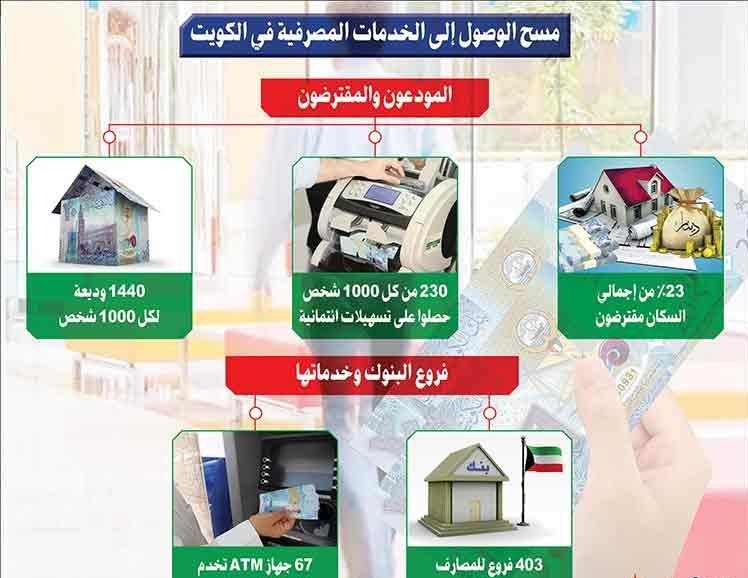
As the percentage of borrowers from commercial banks has increased continuously, Kuwait has witnessed remarkable changes in personal finance and lending sector in recent years.
This goes on to reflect about the development of most aspects of economic activity in the country. Official data from 2015 to 2023 showed that the number of borrowers increased to 23% of the total population in the country.
According to the Financial Services Access Survey, data from the Central Bank of Kuwait revealed, that at the end of last year, 230 people out of every 1000 people in Kuwait are borrowers. This indicates that 23 of them have loans for every 100 people.
This percentage has been increasing annually, specifically since it fell to its lowest levels in the Corona years, which recorded its lowest levels at 20.9% in 2020, equivalent to 209 borrowers out of every 1,000 people.
The data, reviewed by Al-Anba, showed that the percentage of borrowers from commercial banks in the year 2016 amounted to 21.7% of the total. This percentage witnessed a steady increase over the years, until it reached 23% in 2023. Also, this increase indicates an increase in individuals’ reliance on bank financing for various purposes, whether to finance consumer, residential or investment needs.
Regarding the factors influencing the increase in number of borrowers, during the study period, the local economy witnessed relative stability, with a noticeable growth in the number of investment projects and economic opportunities. This stability helped enhance individuals’ confidence in the financial and banking system, which led to an increase in their demand for loans to finance their consumer needs.
To cite, the year 2021 was a turning point after the pandemic, as the number of borrowers rose to 21.67%, which is equivalent to 217 borrowers out of every 1000 adults. This can be considered as an indicator of the recovery in demand for financing after the recession that the country witnessed during the pandemic.
DEPOSITORS
In addition, the number of depositors in commercial banks witnessed a significant increase between 2015 and 2023. The data showed that the culture of saving is widespread among citizens and residents, as the depositor number index revealed that there are 1440 deposits, for every 1000 people.
BANK BRANCHES
Regarding the number of bank branches in Kuwait from 2015 to 2023, the data shows that the number of commercial branches witnessed slight fluctuations over this period, recording about 403 branches by the end of 2023.
It had recorded about 401 branches in 2015, which rose to 409 branches in 2016, and in 2017 it stabilized at 408 branches. In 2018, it reached 411 branches, which is the highest level recorded by the number of commercial branches in the country during the mentioned period, after which the number of branches decreased to 401 branches during 2019.
Moreover, during the Corona pandemic, specifically in 2020, the number of branches decreased to 384 branches, as some banks were forced to either temporarily closes their branches or merge their banking operations due to economic changes.
During 2021, the number of bank branches increased to 403 branches. This recovery indicated a gradual recovery of the banking sector after the effects of the pandemic. It happened primarily due to the reopening of previously closed branches or the due to the opening of newer branches meant to meet the growing needs.
In 2022, the number of branches witnessed a slight decrease to 400 branches. This minor decline may have been due to the reorganization of banking operations and the improvement of electronic services.
As a significant progress despite minor fluctuations, the number of bank branches in Kuwait between 2015 and 2023 appeared to have maintained relative stability, with the banking sector responding to market changes and moving towards digital services.
Whereas in 2023, the number of branches reached 403, reflecting a balance between the changing needs of customers and the banking sector’s trends towards improving efficiency and enhancing digital services.
ATMs
On the other hand, the ATMs witnessed a remarkable development over the years from 2015 to 2023, as these developments reflected the increased reliance on financial technology and the expansion of banks in providing digital services to enhance the banking experience for customers. This initiated an increase in ATMs that reached about 67 machines per 100,000 adults in Kuwait by the end of last year.
This number reflected about the initial base for the deployment of ATMs in Kuwait during that period, as these machines were essential for enabling individuals to quickly access cash and other banking services.
The increasing spread of banking applications and online services, including customers’ growing needs has ensured a shift from traditional cash withdrawals to electronic payments. This has led to a reduction in reliance on ATMs, especially in recent years. Banks have played a major role in facilitating these transformations by offering innovative banking services.
More importantly, despite the digital transformation, banks have continued to improve their ATM networks to offer more comprehensive services such as; bill payments, money transfers, and balance inquiries. These developments have contributed to ATMs remaining a preferred option for many customers, especially those who prefer physical access to cash.
With the increasing reliance on digital banking technology, ATMs are expected to continue to play their role as a key component of the banking network. But their presence may gradually decrease in areas with strong digital banking services. However, ATMs may continue to offer more advanced and diverse services to meet the changing needs of customers.
FUTURE OUTLOOK
As Kuwait’s economy continues to grow substantially, the demand for bank financing is expected to rise further. With the government’s increased support for SMEs and the expansion of the target groups for personal financing, the percentage of borrowers from commercial banks may continue to increase.
In addition, with the continued improvements in the banking system and digital services, it will be easier for individuals to access loans, which will reinforce this upward trend.













